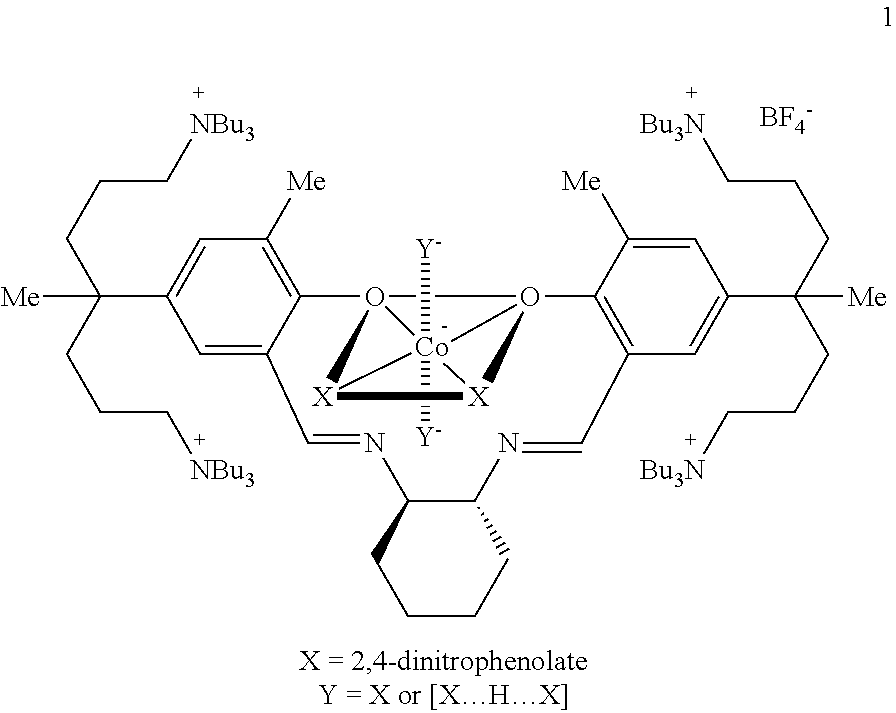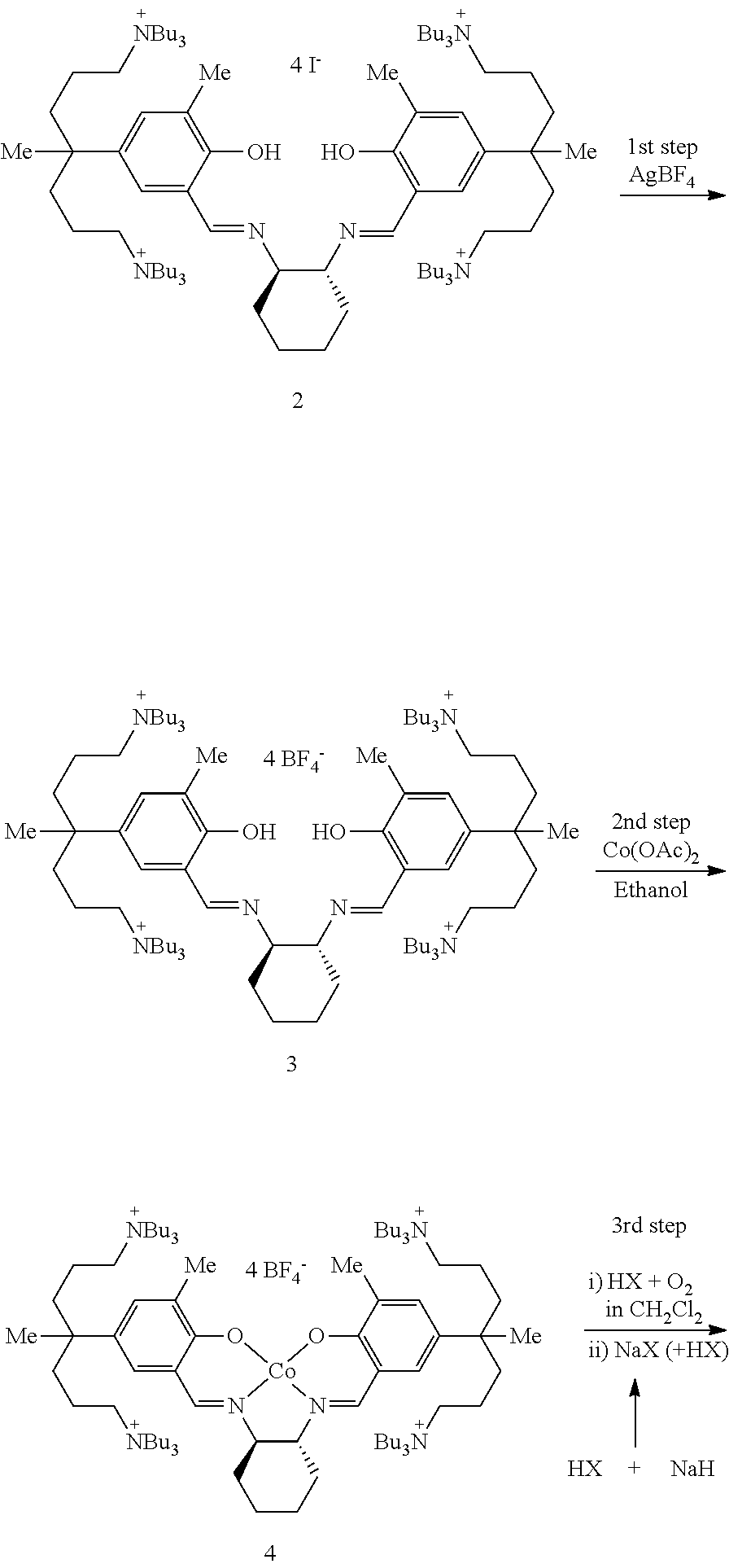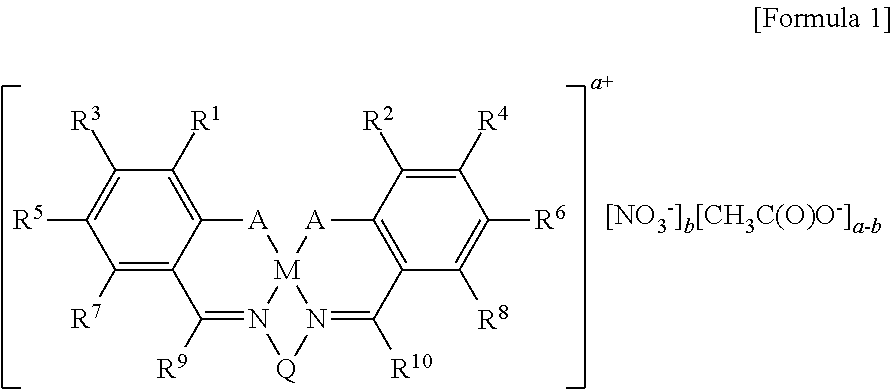Catalytic System of Nitrate Anions for CO2/ Epoxide Copolymerization
a catalytic system and nitrate anions technology, applied in the field of salen type ligands, can solve the problems of high preparation cost of catalysts of structure 1, unsuitable for mass production and continuous use, and increase in resin price, so as to reduce the preparation cost
- Summary
- Abstract
- Description
- Claims
- Application Information
AI Technical Summary
Benefits of technology
Problems solved by technology
Method used
Image
Examples
example 1
Synthesis of Catalyst (Compound C)
[0103]A method of simply and economically synthesizing a catalyst according to the present invention is shown below. Compound A was synthesized using a known method (Bull. Korean Chem. Soc. 2009, 30, 745-748).
[0104]Synthesis of Compound B
[0105]Compound A (100 mg, 0.054 mmol) and AgNO3 (37.3 mg, 0.219 mmol) were dissolved in ethanol (3 mL) and then stirred overnight. The stirred solution was filtered using celite and the produced AgI was removed. The solvent was removed under reduced pressure to yield the product, Compound B as a yellow solid powder (0.80 g, 94%).
[0106]1H NMR (CDCl3): δ 13.51 (s, 2H, OH), 8.48 (s, 2H, CH═N), 7.15 (s, 4H, m-H), 3.44 (br, 2H, cyclohexyl-CH), 3.19 (br, 32H, NCH2), 2.24 (s, 6H, CH3), 1.57-1.52 (br, 4H, cyclohexyl-CH2), 1.43-1.26 (br, 74H), 0.90-0.70 (br, 36H, CH3) ppm.
[0107]Synthesis of Compound C
[0108]Compound B (95 mg, 0.061 mmol) and Co(OAc)2 (10.7 mg, 0.061 mmol) were placed in a flask, and added methylene chloride (...
example 2
Carbon Dioxide / Propylene Oxide Copolymerization
[0114]Compound C (3.0 mg, monomer / catalyst=100,000) prepared in Example 1 and propylene oxide (10.0 g, 172 mmol) were added into a 50 mL bomb reactor, after which the reactor was assembled. A carbon dioxide pressure of 15 bar was applied to the reactor, the reactor was dipped in an oil bath at 73° C., and stirred. After 35 min, the internal temperature of the reactor reached 70° C. and the pressure of the reactor was observed to decrease. The polymerization was carried out for 1 hour. The reactor was dipped in a cooling bath and thus cooled, after which carbon dioxide gas was removed, and the reaction was terminated, resulting in a light yellow viscous solution.
example 3
Catalyst Separation
[0115]To the viscous solution prepared in Example 2 was further added 10 g of propylene oxide in order to reduce the viscosity of the solution, after which the solution was passed through a silica gel (400 mg, manufactured by Merck, 0.040˜0.063 mm particle size (230˜400 mesh)) column, yielding a colorless solution. The monomer was removed using vacuum decompression, thus obtaining 2.4 g of a colorless solid. This yield corresponds to TON (Turnover Number) of 15000, and TOF (Turnover Frequency) of 15000 h−1. The polymer thus obtained had a molecular weight (Mn) of 217000 as measured using GPC and a molecular weight distribution (Mw / Mn) of 1.34. The selectivity for forming a polymer analyzed by 1H NMR was 99% or more.
PUM
| Property | Measurement | Unit |
|---|---|---|
| Equivalent mass | aaaaa | aaaaa |
Abstract
Description
Claims
Application Information
 Login to View More
Login to View More - R&D
- Intellectual Property
- Life Sciences
- Materials
- Tech Scout
- Unparalleled Data Quality
- Higher Quality Content
- 60% Fewer Hallucinations
Browse by: Latest US Patents, China's latest patents, Technical Efficacy Thesaurus, Application Domain, Technology Topic, Popular Technical Reports.
© 2025 PatSnap. All rights reserved.Legal|Privacy policy|Modern Slavery Act Transparency Statement|Sitemap|About US| Contact US: help@patsnap.com



